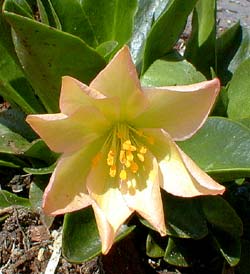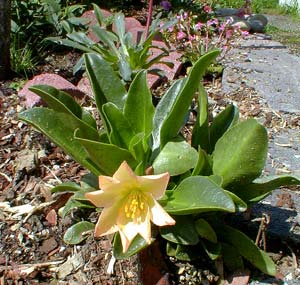 Tweedy's Bitterroot
Tweedy's Bitterroot
"Who would have thought it possible that a tiny little flower could preoccupy a person so completely that there simply wasn't room for any other thought."
-Sophie Scholl
(1921-1943)
(1921-1943)
Ninety percent of the lewisia offerings from growers are Lewisia cotyledon, the hardiest of lewisias, with the greatest natural variation of flower color, & the most amenable to intraspecies hybridization. But L. tweedyi is no longer the alpine rarity for specialized & advanced gardeners.
It has an old history in cultivation even though it has not previoiusly been as widely available as it is today. It was the first lewisia to have the Award of Garden Merit bestowed upon it, way back in 1901.
But during the decade following 1993 when it was reconfirmed after field stsudies for the Award of Garden Merit, it has became increasingly available until, here in the Pacific Northwest at least, it is now the only other Lewisia species besides cotyledon to be quite a common offering from regular ol' nurseries.
The first known cultivated specimen to flower was at Kew Garden in 1898, though having been imported from an Oregon nursery, there is no doubt but that they were gardened in the Pacific Northwest long before the rest of the world found out about Tweedy's Lewisia.
It needs the sharpest possible drainage, but with the proviso that its root crown should never be particularly damp, it will do well for anyone who has already been having good luck with the more commonly offered cotyledon.
Some assess this lewisia as difficult to grow outside the Northwest & only easy here. A couple of growers beg to differe & have assessed it as hardier than L. cotyledon, believing it is not quite as susceptible to rot. Both species do actually stand up to a good deal of rainfall when it can't be escaped, & the real issue is how swiftly the area drains after a hard rain. It's conceivable that both these Lewisias would grow well even in a garden with daily watering, but only if the lewisias were located along a verticle ledge where they would not remain wet for any length of time. All round best, of course, would be to provide a sunny & only sporadically watered spot.
There is also a limit to how much direct sun they appreciate. Lewisias do benefit by locations where at least a small part of the day is shaded, or a part of their root system is shaded by rockery rocks. Northerly or northwest sun exposures are best.
Tweedy's Bitterroot has wide, pointed, succulent leaves in a slightly upright rosette. The leaves are evergreen, but in our garden, probably due to its dislike for the increased winter rainfall rather than because of the temperature, some of the leaves are homely by winters end. I very carefully clip out the largest lowermost leaves to improve its late-winter appearance & make room for pending new growth.
The basal-leaf rosette produces pastel flowers three or four times larger than those of L. cotyledon, though far fewer blossoms overall. Whereas cotyledon produces panicles with hundreds of half-inch blooms through its season (one-inch on some fancier specimens), Tweedy's has only three to a dozen or so two & a half-inch wide funnel-blossoms, popping singly out of the center of the leafy rosette.
 The long, thin, large buds are maturing by early May & in full bloom later in the month. Its natural color is buttery yellow with occasional blushes of pink, & there is also the white form "Alba." The stamins are a brighter yellow. The color range from specimen to specimen is not great as it is for L. cotyledon but one does spot individual Tweedies that have different colored blossoms, mainly pink to apricot.
The long, thin, large buds are maturing by early May & in full bloom later in the month. Its natural color is buttery yellow with occasional blushes of pink, & there is also the white form "Alba." The stamins are a brighter yellow. The color range from specimen to specimen is not great as it is for L. cotyledon but one does spot individual Tweedies that have different colored blossoms, mainly pink to apricot.The seeds have a sweet honey scent which is not manifest in other species of lewisias. This odor is to attract ants, which carry the seeds away, eat the outer skin, & drop the bared seed some distance from the parent, by this method slowly extending the size of a wild colony. Unfortunately it does not set seeds very easily in captivity, so is cultivated from cuttings or from seeds gathered in the wild.
Native to the Wenatchee Mountains of central Washington, where it is locally known as the Mountain Rose, its primary habitat is dry rocky slopes among ponderosa pines. It is a remnant from before the Ice Age, older than the mountains. It is restricted to the Wenatchee range of Chelan & Kittitas Counties, with few additional isolated populations in British Columbia's Methow Valley & in Manning Park, Vancouver. It is presently on Washington's watchlist of species at risk due to over-collecting of specimens or seeds & habitat loss.
There was a well-known botanist named John Tweedie (1775-1862) of the Royal Botanical Gardens at Edinburgh, but Tweedy's Bitterroot is named instead for topographic engineer Frank Tweedy (1854-1937). From 1881 to 1891, Frank made botanical collections for the US Geological Survey of Montana, Idaho, & Washington. He collected the plant that would become his namesake near Mount Stuart of the Winanatchee range in May 1882. Other Northwest native plants bear his name, such as Cascade Reedgrass ( Calamagrostis tweedyi) & Tweedy's Willow (Salix tweedyi).
Lewisia x cotyledon, Praline Red